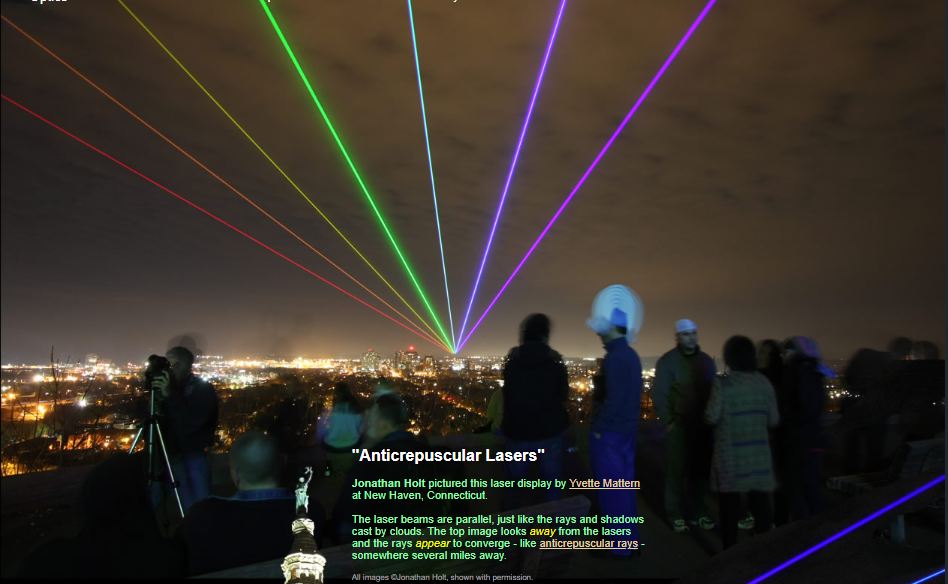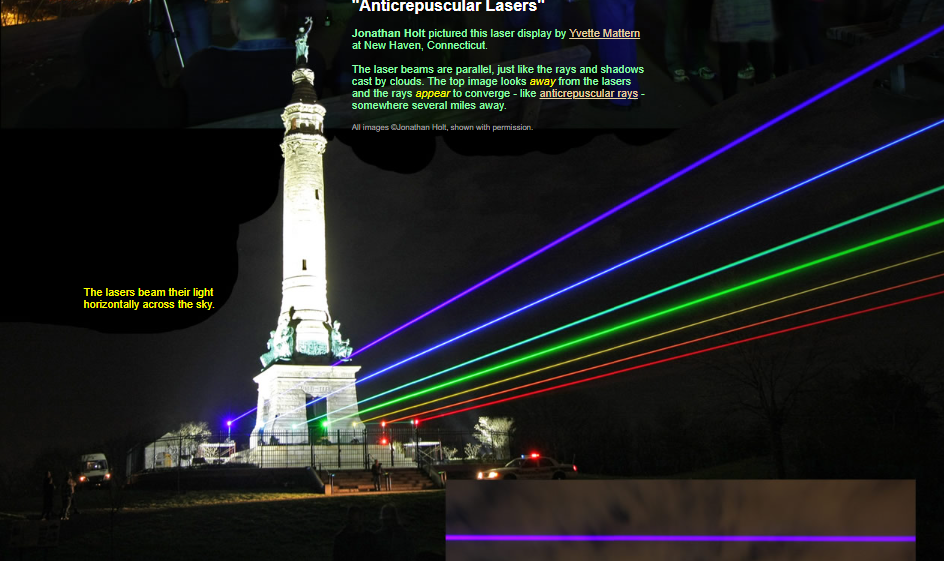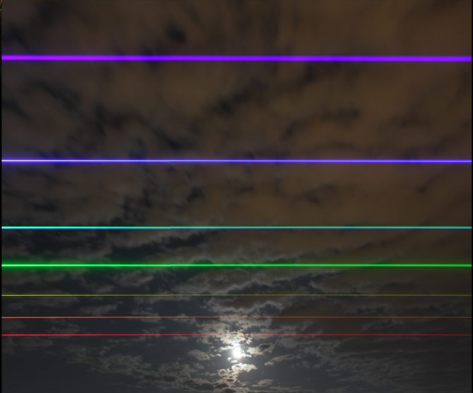OPOD - Parallel rays
OPOD - Parallel Rays: Exploring the Phenomenon of Anticrepuscular Lasers
Have you ever witnessed the mesmerizing display of parallel laser beams cutting through the night sky? Jonathan Holt captured an incredible image of such a spectacle created by Yvette Mattern in New Haven, Connecticut. The beams, just like the rays and shadows cast by clouds, appear perfectly parallel. Interestingly, when looking away from the lasers, the rays seem to converge, resembling anticrepuscular rays that appear to converge several miles away. Let's delve deeper into this fascinating phenomenon and explore the characteristics and appearance of these sun rays and shadows.
The parallel laser beams showcased in the images by Jonathan Holt offer a captivating demonstration of the nature of sun rays and shadows. These beams are truly parallel, providing us with a visual representation of how rays and shadows behave in our atmosphere. As we observe these images, we can draw parallels between the laser beams and natural atmospheric phenomena.
When examining the top image, where the rays seem to converge in the distance, we can compare it to anticrepuscular rays. Anticrepuscular rays are a captivating optical illusion that occurs during sunrise or sunset. These rays appear to converge at a point opposite the sun's position in the sky. Similarly, in Holt's photograph, the parallel laser beams create an illusion of convergence, enhancing their resemblance to anticrepuscular rays.
The phenomenon of parallel rays and shadows is a captivating subject within atmospheric optics. It highlights the intriguing ways in which light interacts with particles and structures in our atmosphere. By studying these phenomena, scientists gain valuable insights into the behavior of light and its impact on our visual perception.
To better understand the concept of parallel rays, it is essential to grasp the basics of atmospheric optics. The atmosphere is composed of countless particles, such as dust, water droplets, and ice crystals, which can scatter and refract light. When sunlight interacts with these particles, it creates a myriad of optical phenomena, including parallel rays and shadows.
When sunlight passes through gaps or openings in clouds, the rays become parallel due to the light's straight-line propagation. These parallel rays can then cast shadows on the Earth's surface, creating intriguing patterns and shapes. The parallel laser beams captured by Holt beautifully mimic this behavior, allowing us to witness the fascinating interplay between light and our atmosphere.
It is worth noting that the phenomenon of parallel rays is not limited to natural occurrences. Humans have harnessed the power of lasers to create similar displays. By emitting parallel laser beams into the atmosphere, we can observe and appreciate the same optical characteristics seen in natural sun rays and shadows.
In conclusion, the captivating images captured by Jonathan Holt provide us with a mesmerizing glimpse into the phenomenon of parallel rays and shadows. By showcasing parallel laser beams that resemble anticrepuscular rays, Holt's photographs offer a unique perspective on atmospheric optics. Through the study of these phenomena, scientists continue to unravel the mysteries of light and its interaction with our atmosphere. Whether in nature or through human intervention, parallel rays and shadows never fail to astound us with their beauty and intricate behavior.

"Anticrepuscular Lasers"
Jonathan Holt pictured this laser display by Yvette Mattern at New Haven, Connecticut.
The laser beams are parallel, just like the rays and shadows cast by clouds. The top image looks away from the lasers and the rays appear to converge - like anticrepuscular rays - somewhere several miles away.
All images ©Jonathan Holt, shown with permission.


The beams really are parallel.
They nicely demonstrate the characteristics and appearance of sun rays and shadows.
Note: this article has been automatically converted from the old site and may not appear as intended. You can find the original article here.
Reference Atmospheric Optics
If you use any of the definitions, information, or data presented on Atmospheric Optics, please copy the link or reference below to properly credit us as the reference source. Thank you!
-
<a href="https://atoptics.co.uk/blog/opod-parallel-rays/">OPOD - Parallel rays</a>
-
"OPOD - Parallel rays". Atmospheric Optics. Accessed on November 26, 2024. https://atoptics.co.uk/blog/opod-parallel-rays/.
-
"OPOD - Parallel rays". Atmospheric Optics, https://atoptics.co.uk/blog/opod-parallel-rays/. Accessed 26 November, 2024
-
OPOD - Parallel rays. Atmospheric Optics. Retrieved from https://atoptics.co.uk/blog/opod-parallel-rays/.